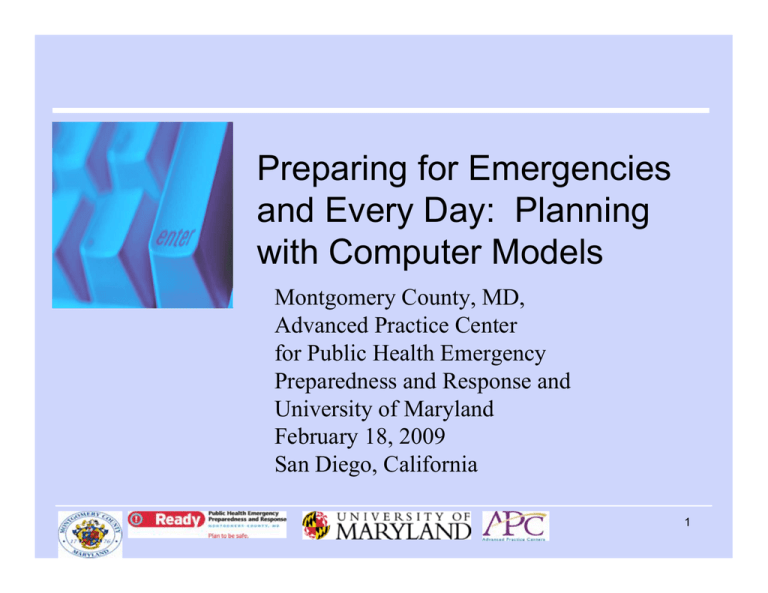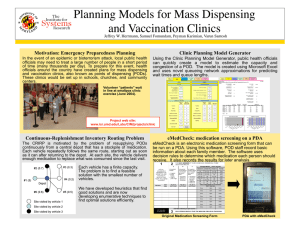Preparing for Emergencies and Every Day: Planning with Computer Models
advertisement

Preparing for Emergencies and Every Day: Planning with Computer Models Montgomery County, MD, Advanced Practice Center for Public Health Emergency Preparedness and Response and University of Maryland February 18, 2009 San Diego, California Planning with Computer Models 1 Introduction: APCs 5 The NACCHO Advanced Practice Centers (APC) Program is a network of local health departments that exist to serve the public health community, developing resources and training materials. 5 The program’s mission is to promote innovative and practical solutions that enhance the capabilities of all local health departments and the public health system to prepare for, respond to, and recover from public health emergencies. Planning with Computer Models 2 Montgomery County, MD APC for Public Health Emergency Preparedness and Response 5 To be a resource in emergency response capabilities for local public health agencies, especially those who are also planning on a multi-jurisdictional area; 5 To collect appropriate tools that other local public health agencies in the National Capital Region have developed for dissemination; and 5 To create and develop toolkits, technologies, and other materials that have been evaluated and tested in Montgomery County, into formats that can be easily replicated and used by other local public health agencies. Planning with Computer Models 3 Overview of Workshop 5Introduce Computer Modeling 5Introduce CRI Scenario Build Clinic Planning Model 5Continue CRI Scenario Plan medication distribution Use electronic screening 5Other uses of models 5Concluding remarks Planning with Computer Models 4 Objectives At the end of this session, participants will be able to: 1. Define the term “computer models.” 2. Identify strengths and challenges to using computer models for local public health departments. 3. Describe at least two examples of how computer models can be integrated into local public health. Planning with Computer Models 5 Introduction: Computer Modeling Planning with Computer Models 6 Models come in many varieties. Planning with Computer Models 7 Defining “Model” 5A model represents a system or process. 5A computer model is a computer program that evaluates the performance of a given system based on data about that system. Includes spreadsheets, specialized software, simulation programs, web-based applications, and others. Planning with Computer Models 8 Planning with Computer Models . . . 5. . . is like using tax preparation software: Requires collecting important data Evaluates your specific situation Automates calculation of critical values Allows rapid recalculation after changes and corrections Requires some time to learn it Planning with Computer Models 9 Models for POD planning 5Operational Assessments for SNS Readiness suggest using a POD planning model. RAND working paper 571, http://www.bt.cdc.gov/cotper/coopagreement/08/pdf/WorkingPaper-Drills.pdf 5Available models: BERM RealOPT Clinic Planning Model Generator Planning with Computer Models 10 Model comparison Model: BERM RealOpt CPMG Platform: Web browser Java program Excel spreadsheet Model type: Simulation Simulation, optimization Mathematical equations POD design: Fixed Flexible Flexible Access: Go to URL Request from developers Download from website Planning with Computer Models 11 Weill Cornell Bioterrorism and Epidemic Outbreak Response Model (BERM) 5Developed by the Cornell Institute for Disease and Disaster Preparedness (available at www.simfluenza.org) 5Features: Estimates staffing needed to meet dispensing requirements Uses simulation to determine and graph queue lengths at each station (greeting, triage, evaluation, dispensing) Web-based tool Planning with Computer Models 12 RealOPT 5Available from the Center for Operations Research in Medicine and Health Care at Georgia Tech 5Features: Includes simulation and optimization modules to determine staffing that optimizes performance in user-defined scenarios Includes graph drawing tool for layout Implemented in Java Planning with Computer Models 13 Clinic Planning Model Generator (CPMG) 5Collaboration between University of Maryland and Montgomery County, Maryland 5Features: Spreadsheet-based program that builds a customized POD planning spreadsheet model Estimates POD capacity and queueing Requires Microsoft Excel 2003 Planning with Computer Models 14 CPMG Development 5The planning models use data collected from time studies of mass dispensing and vaccination exercises in Maryland, Virginia, and New Jersey 5We developed the spreadsheets based on input from public health planners around the country. Planning with Computer Models 15 Personal Testimony 5How many patients per hour? 5How large of a facility is needed? 5How much staff is needed? 5How do you determine most efficient flow pattern for your POD? 5Needed another planning tool that engaged technology in a efficient way 5Time Study Baseline data Creation of Model Planning with Computer Models 16 Viewing and editing the model Planning with Computer Models 17 Model Scope 5Planning, not a training tool 5Only takes into account essential station staff 5Included, but not predicted: Security Runners Translators Data Entry Logistics Planning with Computer Models 18 Model Scope 5 One of many tools for planning Not the silver bullet of POD planning 5 Basic computer skills needed Microsoft Office Excel 5 Unexpected situations Lost children, media, health emergencies 5 Human factor 5 Doesn’t predict supplies needed 5 Numbers in model based on a limited data set Planning with Computer Models 19 How can the model help you? 5Self-select stations 5Decrease bottlenecks/congestion 5Predicts essential staffing 5Compare arrival patterns Buses vs. individual 5Pre-Event and during an event 5User-friendly Planning with Computer Models 20 How can the model help you? 5Evaluation tool of POD plans 5Cost-effective 5Versatility of model Seasonal flu clinics-not always for a crisis 5Field tested and research based Planning with Computer Models 21 User Guide Information 5User Guide can be used for single use or “Train the Trainer” presentation 5For the most updated version of the User Guide and Model go to: Institute for Systems Research, University of Maryland www.isr.umd.edu/Labs/CIM/projects/clinic/ Planning with Computer Models 22 Patient Waiting in PODs 5 Waiting occurs when systems with variability operate near capacity. 5 Excessive waiting provides an opportunity to improve POD design. Waiting for screening station June 21, 2004 Planning with Computer Models 23 Clinic Planning Model Generator Demonstration (CRI Scenario) Planning with Computer Models 24 CRI Background 5The Cities Readiness Initiative (CRI) is a federally funded effort to prepare major US cities and metropolitan areas to effectively respond to a large scale bioterrorism event by dispensing antibiotics to their entire identified population within 48 hours of the decision to do so. Planning with Computer Models 25 CRI Scenario 5 There has been an aerosolized Anthrax attack in Anywhere, USA. It has a population of 500,000 residents. There are 65 elementary schools that will be used to distribute oral medication. Household Representatives will be asked to walk to the nearest elementary school. Anywhere’s Local Health Department is given 24 hours to distribute the medication, requiring two 12 hour shifts. 5 Problem: Determine the number of staff needed to deliver medications to 500,000. Use two stations Greeting and Delivery. 5 Go to CPMG Planning with Computer Models 26 Example: Input Data Size of population to be treated: 500,000 Time for treatment (days): 1 Hours of operation per day: 24 Number of PODs: 65 Planning with Computer Models 27 500,000 Worksheets 1 24 65 G reetin g Greeting 1 00 % D ispen sin g 1 00 % Dispensing Dispensing Exit 1 2 Ex it Planning with Computer Models 28 Model creation 5 Launch the CPMG (enable macros) and enter setup information Planning with Computer Models 29 Model creation 5 Select stations in clinic 5 Select ‘OK’ and save clinic Planning with Computer Models 30 Model creation 5 Enter station names… 5 ….and routing data Planning with Computer Models 31 Viewing and editing the model 5Navigate to Main page Planning with Computer Models 32 Planning with Computer Models 33 Viewing and editing the model Planning with Computer Models 34 Viewing and editing the clinic Planning with Computer Models 35 What if? 5 What happens if we add a person to the station with the highest utilization? Add 1 to number of dispensing staff: Planning with Computer Models 36 What if? 5 Adding 1 to dispensing impacts POD performance: POD capacity: 343 to 400 patients per hour Time in POD: 5.35 mins to 1.83 mins Patients in POD: 29 to 10 Waiting time at dispensing: 3.78 mins to 0.26 mins Queue length at dispensing: 20 to 1 Planning with Computer Models 37 Medication Distribution Model Planning with Computer Models 38 CRI Scenario: Medication Distribution 5Medication flow: Strategic National Stockpile (SNS) and Vendor Managed Inventory (VMI) State Receipt, Store, and Stage (RSS) facility Local Distribution Center (LDC) Points of Dispensing (PODs) 5Multiple shipments to RSS require good plans to get medication to PODs on-time Planning with Computer Models 39 CRI Scenario: Medication Distribution 5Slack = how early are deliveries to PODs? More slack is better: more robust plan that can handle disruptions 5Synchronizing operations is key to increasing slack. Planning with Computer Models 40 CRI Scenario: Medication Distribution Planning 5Inputs: Timeframe Shipments to RSS: time, quantity PODs: location, demand Vehicles: number, capacity 5Output: Routes for vehicles Delivery schedule with quantities Planning with Computer Models 41 Medication Distribution Planning Process Planning with Computer Models 42 CRI Scenario: Medication Distribution Planning 5Routing: Uses TourSolver (cdcstockpilerouting.c2logix.com) to generate vehicle routes 5Scheduling: Uses tested rules to schedule deliveries and determine best quantities Planning with Computer Models 43 CRI Scenario: Medication Distribution Planning 5Go through CRI example Planning with Computer Models 44 Delivery “Waves” 5Wave: A delivery to depot (RSS) followed by deliveries from depot to PODs. 5Distribution to PODs is limited by these waves. 5Our CRI Scenario: 6 waves. 5 hours between waves. Planning with Computer Models 45 1. Generate Routes Planning with Computer Models 46 2. Scheduling 5Inputs: Supply and Demand 5Output: Vehicle start times Minimum slack for each wave 5Assumptions: equal-sized deliveries to depot, all PODs have same dispensing rate, one delivery to each POD each wave, all vehicles start simultaneously. Planning with Computer Models 47 Planning with Computer Models 48 9,000 8,000 POD delivery chart 7,000 Quantity (regimens) 6,000 5,000 4,000 3,000 Delivered Slack Demand 2,000 1,000 0 0:00 6:00 12:00 18:00 24:00 30:00 36:00 Time from start (hh:mm) Planning with Computer Models 49 eMedCheck Electronic Patient Screening Planning with Computer Models 50 CRI Scenario: Patient Screening Planning with Computer Models 51 CRI Scenario: Patient Screening Planning with Computer Models 52 CRI Scenario: Patient Screening Planning with Computer Models 53 CRI Scenario: Patient Screening Carla Court is a 55 year old female with allergies to doxycycline and ciprofloxacin. She lives with her 56 year old husband David Court who has no allergies. Planning with Computer Models 54 Patient Screening Step One Planning with Computer Models 55 Patient Screening Step Two Planning with Computer Models 56 Patient Screening Step Three Planning with Computer Models 57 Patient Screening Step Four Planning with Computer Models 58 Patient Screening Next Person Planning with Computer Models 59 Planning with Computer Models . . . 5. . . can be used for more routine operations: Tuberculosis screening at high schools Seasonal flu clinics Other immunization clinics Planning with Computer Models 60 Objectives At the end of this session, participants will be able to: 1. Define the term “computer models.” 2. Identify strengths and challenges to using computer models for local public health departments. 3. Describe at least two examples of how computer models can be integrated into local public health. Planning with Computer Models 61 Concluding Remarks 5We encourage you to use these tools and provide feedback to use so that we can continue to improve them and develop useful new ones. Planning with Computer Models 62 A Final Thought 5 Modeling should create a conversation, not answer a question. Planning with Computer Models 63 Contact Information 5 For more information about the Montgomery County Advanced Practice Center (APC) and tools please refer to the following website: http://www.montgomerycountymd.gov/apc 5 Or contact: Kay Aaby, APC Program Manager kay.aaby@montgomerycountymd.gov Dr. Jeffrey Herrmann, University of Maryland jwh2@umd.edu Planning with Computer Models 64 5Questions Planning with Computer Models 65





